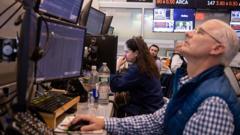Following Trump’s announcement, which came less than 24 hours after the imposition of new tariffs, the stock market rallied. The Dow jumped over 7.8%, while the Nasdaq experienced a staggering increase of 12%. However, the market's mood shifted dramatically after earlier concerns regarding a possible economic downturn led to panic selling in the bond markets.
While Trump's trade strategy included an increase of tariffs on China goods to at least 125%, the suspension provided relief for companies heavily reliant on imports. Major brands such as Nike and Apple saw substantial stock increases, with Nike climbing 11% and Apple by approximately 15%. Yet, despite this bullish day, stock indexes remained lower than prior to Trump's initial tariff declarations.
The subsequent political pressure and economic warnings prompted a reconsideration of the hardline approach to tariffs. Trump expressed intentions to negotiate with China and indicated potential exemptions for specific companies. Nevertheless, he remained committed to maintaining tariffs on vital sectors, including automotive and aluminum industries. As the economic landscape reshapes following the tariff suspension, all eyes will be on how negotiations evolve and their impacts on the future of US trade relations.
The swift policy shift and its reception underscore the delicate balance Trump must maintain in responding to both economic indicators and political pressures from influential allies.
While Trump's trade strategy included an increase of tariffs on China goods to at least 125%, the suspension provided relief for companies heavily reliant on imports. Major brands such as Nike and Apple saw substantial stock increases, with Nike climbing 11% and Apple by approximately 15%. Yet, despite this bullish day, stock indexes remained lower than prior to Trump's initial tariff declarations.
The subsequent political pressure and economic warnings prompted a reconsideration of the hardline approach to tariffs. Trump expressed intentions to negotiate with China and indicated potential exemptions for specific companies. Nevertheless, he remained committed to maintaining tariffs on vital sectors, including automotive and aluminum industries. As the economic landscape reshapes following the tariff suspension, all eyes will be on how negotiations evolve and their impacts on the future of US trade relations.
The swift policy shift and its reception underscore the delicate balance Trump must maintain in responding to both economic indicators and political pressures from influential allies.





















